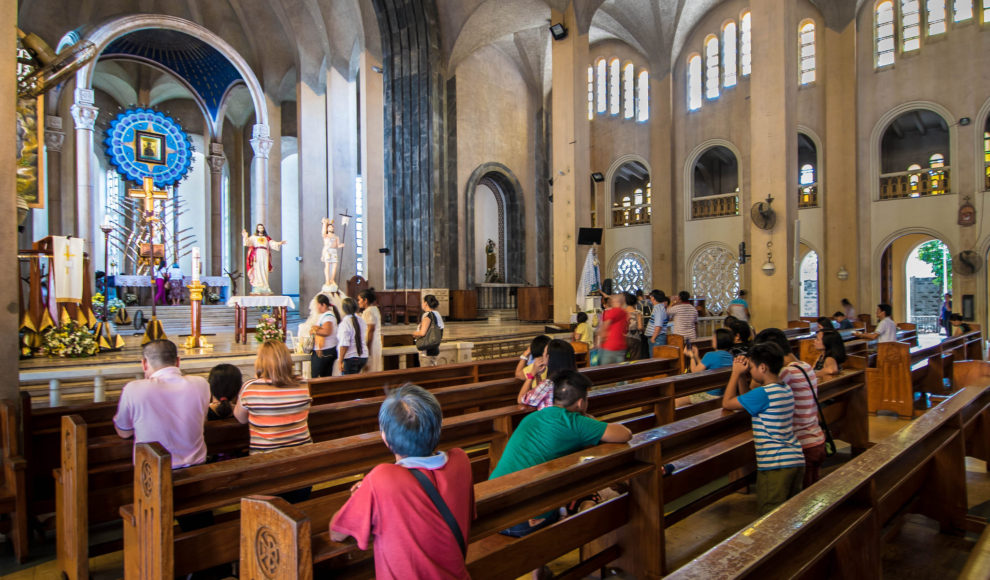Communal forms of religious participation sometimes come under criticism for promoting narrow-minded perspectives or even contributing to violence and terrorism. While these critiques are sometimes warranted, those leveling them too often ignore positive aspects of communal religious participation. The various ways in which religious participation contributes to human well-being are, of course, complex, but empirical research has been building over the last couple of decades that suggests a number of specific and powerful effects.
For instance, recent research published in the Journal of the American Medical Association’s JAMA Internal Medicine and JAMA Psychiatry and in the Annals of Behavioral Medicine indicates that regular religious-service attendance is associated with a number of positive outcomes, including: a roughly 30 percent reduction in mortality over 16 years of follow-up; a five-fold reduction in the likelihood of suicide; and a 30 percent reduction in the incidence of depression. These studies, from my colleagues and me in Harvard’s T.H. Chan School of Public Health, used data from the Nurses’ Health Study, a long-term study of approximately one hundred thousand nurses with data collected over several decades. The results confirm associations between religious-service attendance and health previously reported in the research literature.
However, prior studies had come under criticism for not considering the possibility of “reverse causation.” Perhaps only those who are healthy can attend religious services, so that health is a cause of attendance rather than the reverse. The new research addresses this by using repeated measurements of service attendance and health over time, thereby controlling for whether changes in health preceded changes in service attendance or vice versa. The associations between religious-service attendance and longevity, suicide, and depression all remained robust.
Moreover, forthcoming research I have worked on, to be published in the American Journal of Epidemiology, indicates that service attendance itself — rather than self-assessed religiosity or spirituality or even solitary spiritual practice — is the most reliable predictor of health. Something about communal forms of religious participation seems to be important. And other past studies have indicated that the effects of communal religious participation extend not just to health, but to many other positive outcomes. These include: greater likelihood of healthy social relationships and stable marriages; an increased sense of meaning in life; higher life satisfaction; an expansion of one’s social network; and more charitable giving, volunteering, and civic engagement. In sum, the positive effects of religious-service attendance appear to be significant across a broad range of outcomes.
What are the implications of these findings? First, they may help religious communities by supporting a message about the power and importance of communal religious life. That it is religious-service attendance, rather than private practices or self-assessed spirituality, that seems most clearly to affect health in the general population suggests that there is something uniquely important about the communal religious experience. In an era in which Americans increasingly self-identify as “spiritual but not religious” and a growing number are unaffiliated with any “organized religion,” this empirical research carries a powerful message that religious leaders can communicate. Theologians have long argued on theological grounds that religious community is important; the empirical research now supports that contention.
Second, these findings may help health-care providers by giving insight into how religious participation can be a powerful social determinant of health. The role of religion and spirituality in patient care remains controversial. The majority of patients say they think that physicians should consider their spiritual needs, but many physicians feel uncomfortable doing so. How might these complexities be navigated? Some researchers have suggested that patients be given a short, four-question spiritual history in the clinical context:
- Is faith (religion or spirituality) important to you in this illness?
- Has faith been important to you at other times in your life?
- Do you have someone to talk to about religious matters?
- Would you like to explore religious matters with someone?
Answering such questions may help a health-care provider assess whether religious faith plays an important role in a patient’s life and whether the issues should be discussed further or if a referral should be made.
Of course, the research results on religion and health certainly do not imply that physicians should universally “prescribe” religious-service attendance. Decisions about religious practice and the formation of religious beliefs are generally not made on the grounds of health, but rather reflect values, relationships, evidence, thought, upbringing, and numerous other commitments and experiences. But for those who do already identify as religious, service attendance might be encouraged, even in the clinical setting, as a form of meaningful social participation. Due caution may be needed for those patients who have had prior negative experiences in religious settings or communities. But something like the above questionnaire may help assess whether this is the case.
Given the empirical evidence for the positive health effects of communal religious participation and the fact that 36 percent of Americans report attending religious services at least weekly, religious participation should no longer be neglected as a social determinant of health in medical research and in medical and public health practice.
Why is it that communal religious participation appears to have such powerful health effects? One obvious explanation is social support: By attending religious services, one develops social support that, in turn, positively affects one’s health. But while the research suggests that social support is important, it nevertheless appears to account for only about 20 percent to 30 percent of the reported association between attendance and health. Several other mechanisms appear to be important as well.
In the United States at least, the social and behavioral norms associated with religious services appear to lead to a reduced likelihood of smoking, which, of course, may positively affect health. Another possible explanation concerns one’s outlook on life. Those who attend religious services appear to have higher levels of optimism and lower levels of depression, and these, in turn, have been linked to positive physical health and longevity.
The recent research results suggest that all of these mechanisms may be important. And there are probably others as well, including the development of self-discipline or a sense of meaning and purpose. It seems as though the association between service attendance and health cannot be explained by just one mechanism. Rather, there appear to be many pathways from religion to health. Religious-service attendance affects many aspects of one’s life, and the cumulative effect seems to have a substantial, positive effect on one’s health.
Are these mechanisms fundamentally religious in nature? After all, social support, not smoking, optimism, and the like are not peculiar to religious practice. Might these pathways to health be available by other, non-religious means? Of course. But careful consideration of how religious services may affect various aspects of one’s life suggests that the role of religion may, in fact, be important.
Of course, social support is present in numerous secular contexts. But within the religious context, the concept of community often takes on singular practical and theological importance. If the communal experience of common worship and common values have religious content, perhaps the resulting communal support is both social and religious in nature. Similarly, while the concept of optimism is not inherently religious, the message of faith and hope present in religious preaching, readings, and music is central to many religious groups. Even something as seemingly non-religious as giving up smoking may partly be explained by the emphasis of some religious groups on vice or the idea that the human body is a temple of God. This belief may be reinforced by regular participation in religious community; the beliefs, and their reinforcement, and resulting subsequent social norms may result in lower rates of smoking. The religious beliefs may thus, even here, be quite central.
We can always ask if such mechanisms are really “religious” or just “social.” But the above considerations suggest that the answer may be “both.” Likewise, hypothesized mechanisms of a shared sense of meaning or purpose in life, or a shared communal outlook shaped by faith, hope, and love, are both religious and social. There may be no good way to separate the religious and the social here, and it is perhaps the intertwining of the two that gives religious-service attendance its power to shape so many life outcomes.
Discussion Questions:
- What are the individual and societal implications of the relationships between religion and flourishing?
- How might health be conceptually linked to religious understandings of wholeness or salvation?
- What is it that takes place at religious services that may be so powerful?
Discussion Summary
The short piece I wrote on religious community and human flourishing noted that religious participation was associated with numerous positive outcomes including greater longevity, less depression, less suicide, greater life satisfaction, greater meaning and purpose, less divorce, greater social support, more charitable giving and civic engagement. Several questions emerged from the discussion. One was whether this was specifically a religious phenomenon, or whether it extended to other forms of communal activity. Certainly other forms of communal activity are important for health and other outcomes. When they have been compared, the size of the effects for religious service attendance does seem larger, but certainly community involvement generally is beneficial for flourishing as well. We are social beings and need other people. It is perhaps the intersection between social involvement and religious ideas that gives religious service attendance its substantial effects on so many outcomes.
Another interesting question that came up was the implications of this research. A health-care provider might consider asking about whether faith shapes a patient’s way of thinking about illness and health. For patients who already self-identify as being religious, service attendance could perhaps be encouraged, when appropriate, as a meaningful form of social engagement. Those who rely solely on solitary spirituality may want to reconsider their approach and whether communal religious involvement might provide something which they are missing. Something about the communal religious experience seems important for health and for many other outcomes as well.
New Big Questions:
- To what extent does religious upbringing, rather than current religious service attendance, affect flourishing outcomes?
- Does religious service attendance have larger effects on health maintenance or on healing and recovery amidst illness?












Fascinating essay. Quite aside from the intriguing empirical evidence of the ‘utility’ of communal religious services, I’m struck by the similarity (and perhaps even commonality) with the domain of, and debate around, the ‘utility’ of basic science. There is good evidence — for my part it is persuasive in the history — that truly foundational and even miraculous advances in science generally occur serendipitously from the undirected pursuit of basic science solely driven by a scientist’s curiosity, and not because that researcher was directed to seek some specific purpose; i.e., the research was not pursued for its “utility,” but (unintended) salutatory outcomes/discoveries nonetheless can (and often) end up having utility. Thus the paradox of there being a utility by ignoring utility as a motivating purpose— emerging from both curiosity-driven basic scientific research, as well as apparently theologically-driven communal religious attendance. Go figure.
Communal forms of religious participation, mentioned in the article, can have an overall positive effect in the flourishing of the physical, mental, and social life especially when the participants are adequately informed of the rationale of the effort. From many of his clinical studies, Carl Jung, the eminent psychologist, observes that people who get relief from mental and physical afflictions are those who have turned to religion. He says, “We moderns are faced with the necessity of rediscovery of the life of the Spirit. We must experience it anew ourselves. It is the only way in which we can break the spell that binds us to the cycle of biological events.”
This ‘rediscovery’ and ‘experiencing anew the Spirit’ naturally call for a rational understanding of what is meant by ‘the life of the Spirit.’ It is the lack of this basic discerning that often contributes to a degrading of the communal forms of religious participation into violence and terrorism. The awareness of the scientific rationale of religious pursuit to know the Spirit will have positive impact both on such communal forms of religious participation or on private spiritual practice. Unless such an understanding is imbibed both may not yield positive results. On the other hand, it may result in negative side-effects as superstition, intolerance, conflicts, wars, and bloodshed.
Religious associations and service attendance have, of course, a special social significance as kindred minds have a common platform to share. But unless they try to evolve a broad and universal spiritual vision along with it , there is the danger of such groups turning out to be narrow, fanatical, and inhuman. The emergence of such negative behavioral patterns are the cause of many a conflict and social problem the world over. Healthy relationships in social and family life can ensue only when there is the cultivation of an in-depth scientific awareness of the goal of the religious instinct.
When viewed from a larger biological perspective, religious striving in the human context is a natural outcome of the forward evolutionary thrust of the stream of life to ever greater stages of expression of the higher faculties inherent in nature and evolving to greater dimensions of spiritual freedom. This character and objective of life can be accessed from the gradual emergence of positive values which any keen observer can perceive in the higher forms of life.
If we view human life from this broader perspective of the biological evolutionary trends, it will be evident that both the communal religious services and personal spiritual practice have a special relevance in realizing the higher human potentials, which will refine life by canceling the negative trends, helping it to embrace overall health and cultivate optimism for advancing to a greater life. If we perceive these question from such an angle, we will see the organic evolutionary theory of Darwin and the yogic evolutionary wisdom of Sage Patanjali complementing each other to realize the divine potentials in human existence.
(From K.B. Nair, Editor, Integral Books Pvt.Ltd., who writes in his penname Srikant and is the author of The Self: A Biological Introduction to the Bhagavad-Gita and a few other books linking spirituality and science.)
To what extent is this a specifically religious phenomenon? Couldn’t other, secular social practices that are both collective and explicitly community-oriented fulfill a similar social function?
That is a good question. Other forms of community participation are also associated with subsequent better health. In general, the magnitude of the effects that are estimated are somewhat small than for religious service attendance. In the Nurses’ Health Study data that we analyzed religious service attendance was a stronger predictor of health and longevity than any of the other social support variables, including being married, number of close friends, number of close relatives, having recently seen a friend or a relative, and hours in social groups. My speculation, though we do not have data on this, is that forms of community participation that had not just regular meetings but also a shared set of values, a unified purpose or mission, and a long history would have larger effects on health than those that did not. So participation in a volunteer or political organization, for instance, might have larger effects on health than, say, showing up weekly for a card game. However, this would again require further research. I do think that these other forms of social participation with shared values and missions are important, but also perhaps rarer. What is remarkable about religious service attendance is not simply that it has these shared elements but also that it is so common: About 36 percent of Americans report attending religious services once a week. So participation is common and the effects are large.
How much of this has to do with intentionality? What I’m thinking is that it sounds almost as though the benefits of religious practice are rooted in one’s intention: to be a part of a community, to help others, to beyond oneself, rather than just trying to advance one’s own self-interest.
There are probably effects that are grounded in intention and in helping others, but I do think the benefits of religious communities extend beyond that as well. One interesting study recently provided preliminary evidence that the giving of social support is more strongly associated with well-being than the receiving of social support. It would be interesting to carry out further research on this question.
Thank you, Professor VanderWeele. You mention having health-care providers assess whether religious faith plays an important role in their patients’ lives. This is interesting. But it also sounds like something that might make a lot of secular members of the medical profession pretty queasy. How receptive do you think health-care providers would be to this? Have you recommended this or had any other first-hand experience trying to get the medical profession to see the importance of your findings?
It is indeed a difficult question. Most patients would like clinicians to inquire, and most clinicians feel somewhat uncomfortable doing so. In end of life settings, many national and international palliative care guidelines suggest that spiritual care be included, but even in those settings it is provided relatively infrequently. Training is an important predictor of the provision of spiritual care, but training itself is received by health-care providers infrequently. Many medical schools now offer training, but it is generally only as an elective and most do not receive such training. My colleagues and I have published some work on this question. I think further research and reflection on this issue would be good.
I teach biology, and I’m wondering whether this might help explain why the propensity for religious belief developed in human beings in the first place. Has there been much research on this aspect of the topic at all?